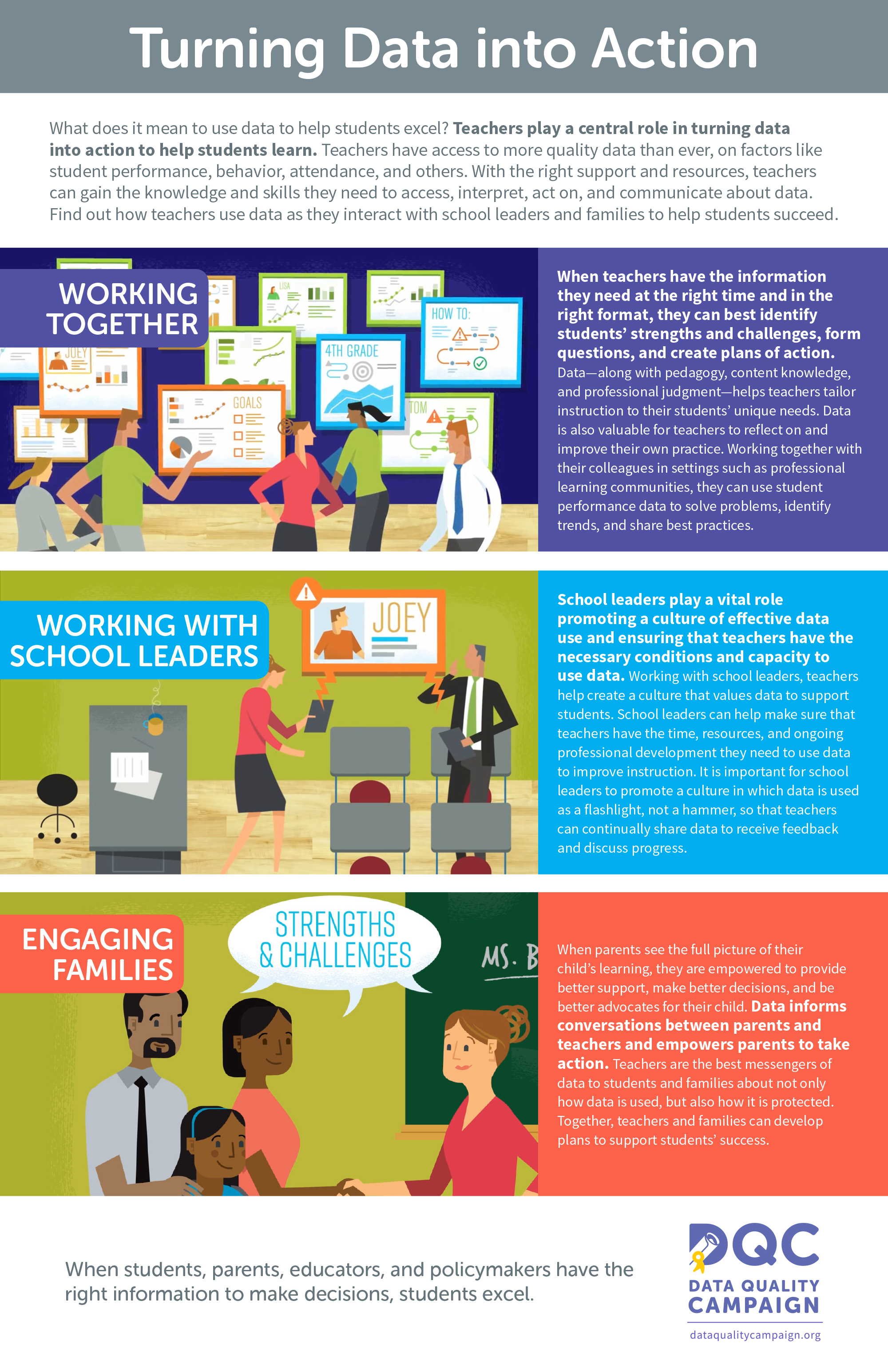Josh Parker is an instructional coach at District of Columbia Public Schools. He was named Maryland State Teacher of the Year in 2012. Brennan McMahon Parton, Data Quality Campaign’s associate director of state policy and advocacy, recently spoke with him about data literacy for teachers.
Brennan McMahon Parton: Josh, thanks for talking to me about data literacy. At the Data Quality Campaign, we define a data-literate educator as someone who has the knowledge and skills to access, interpret, act on, and communicate about data to support student success. Teachers have told us that they see data as a valuable tool for improving instruction and ultimately outcomes for students, but what’s standing in the way of teachers effectively using data?
Josh Parker: In the era of big data, we find ourselves in a paradox where we are data-rich, but information poor. We have access to a range of data points, but our understanding of what they measure, why they matter, and how they impact practice is shallow. Teachers have essential access to data, but they need greater understanding of data interpretation and analysis. It is difficult for teachers to really understand what data to act on and how assessment results should change their daily practice.
Parton: It makes sense that data use is more of a challenge than data access. Too often teachers start their careers without the data literacy skills they need. We believe that data literacy should be included in all educator preparation programs and on licensure exams to help ensure that teachers have the right skills when they enter the classroom.
Parker: Including data literacy on licensure exams would be a big step in the right direction to make sure that teachers have the skills they need to be successful. This is especially important because teachers have so many other things to get adjusted to, learn, and frankly, worry about.
Parton: Absolutely, and teachers also deserve quality ongoing professional development, especially to stay up-to-date as tools and best practices change over time. What do you think effective data literacy training looks like since they build on each teacher’s individual judgment and pedagogical expertise?
Parker: Fundamentally, effective data literacy training focuses on principles and practices. Effective training emphasizes certain principles to consider when looking at data. Principles such as there should be data from multiple sources and data is only as good as the instrument or assessment from which it is derived. Another principle is that qualitative data is the complement to quantitative data and should not be disregarded.
After establishing principles, participants should learn about the practices that help them make instructional changes from data analysis. An ideal data literacy program provides teachers with tools to organize their data and guidelines on how to understand and analyze it to help teachers make the connection of the data to their practice. Teachers’ observational data would be helpful to include here as well.
I also see a co-planning element reinforcing the data analysis. When this process is in the early stages of a school year, teachers are set up pretty well for an impactful rest of the year. Unfortunately, I haven’t worked at any school where this was the case. In fact, explicit training on what assessments mean and how to act on the data either didn’t happen or I can’t remember.
Parton: Some good news is that the Every Student Succeeds Act (ESSA) now allows Title II dollars to be used for data literacy training. Hopefully states and district leaders will leverage these additional resources.
Parker: I hope that administrators take advantage of it. Administrators also play a vital role in teachers’ data literacy. It can be difficult to provide successful professional development during the school year, but it has a different level of potency when it’s embedded right into teachers’ work. Teachers have individual strengths and weaknesses, which should be incorporated into effective professional development as well.
Parton: Building on your important point about individual strengths and weaknesses, how can teachers effectively use data to help tailor instruction to the individual needs of their students?
Parker: Differentiation has become such a trite phrase, possibly because it has been misapplied and misused. There is no way to make thirty different lessons for thirty or more different students. Yet there are ways within lessons to meet the learners’ needs. Students bring their individual cognitive, social, emotional, and cultural selves into each lesson. The degree to which teachers can gather data along those lines will determine how they can tailor instruction to meet the needs of diverse learners. One example of this is that my school implemented tiered warm-ups where there are three different levels in each question. The first level is focused on a general or global understanding of the topic, and the next two questions are increasingly difficult. Teachers can engage with students differently, giving feedback and affirmation that speak to the social and emotional contexts of each student.
Parton: You pretty much summed up why being a teacher is so challenging . . . yet so important a role in a child’s life. How else can data literacy help teachers support their students’ learning?
Parker: To promote students’ deep learning, we need to be looking at the right qualitative and quantitative indicators to make sure that students are progressing. There are different types of data that ensure that students are on the right path to proficiency. And when a student is falling behind, data can be used as a tool to get students back on track. Teachers also should communicate progress to students and families to foster learning and growth towards individual students’ goals. Student ownership and understanding of his or her own data can help foster a sense of ownership over their own educational journey.
Parton: It’s the state’s responsibility for supplying teachers with secure longitudinal data so that they can use it alongside their moment-to-moment data from the classroom to provide that fuller picture. Without data on their progress, teachers are often shooting in the dark and may not be able to identify which practices are and are not working for their students. How can teachers use their student data to get better at their practice?
Parker: When teachers reflect and act on the information from formal observations and connect the teacher action to the student product, there can be great instructional changes. As teachers think about their feedback, it is essential that teachers ask questions such as “What did the evaluator say that I have heard before?” to help situate the feedback as valid and necessary, rather than something to be critiqued.
Parton: Developing a strong school culture of data use is critical to supporting individual teachers’ data literacy. We are proponents of data serving as a flashlight, not a hammer. What are some essential elements for improving the culture of data use in a school?
Parker: If data is the four letter word that sends teachers running for cover, school leaders and administrators most likely have not done the actions that are necessary for creating a positive climate for data analysis and use. Imagine we are walking into a school where the principal routinely has Feedback Fridays, where teachers are able to give feedback to the administration, receive feedback from their peers, and process feedback from at least one assessment during the past week. Teachers and administrators are then given release time to plan a response to the data. These responses are then shared with students, parents, and peer teachers for support, encouragement, and revision. In this school, data sharing is expected, understood, supported, and evaluated in a collaborative environment. This is a school where teacher and administrator practices will change because the culture supports it.
Parton: That’s exactly the vision that we at Data Quality Campaign advocate for. This seems like a good place to wrap up. Thank you for sharing your insights, Josh!
Parker: Nice talking to you, Brennan. Data is so much more than just numbers and technology. Data breathes life into standards and curriculum, showing a rich picture of student learning to help teachers, schools, and systems meet students’ needs.



